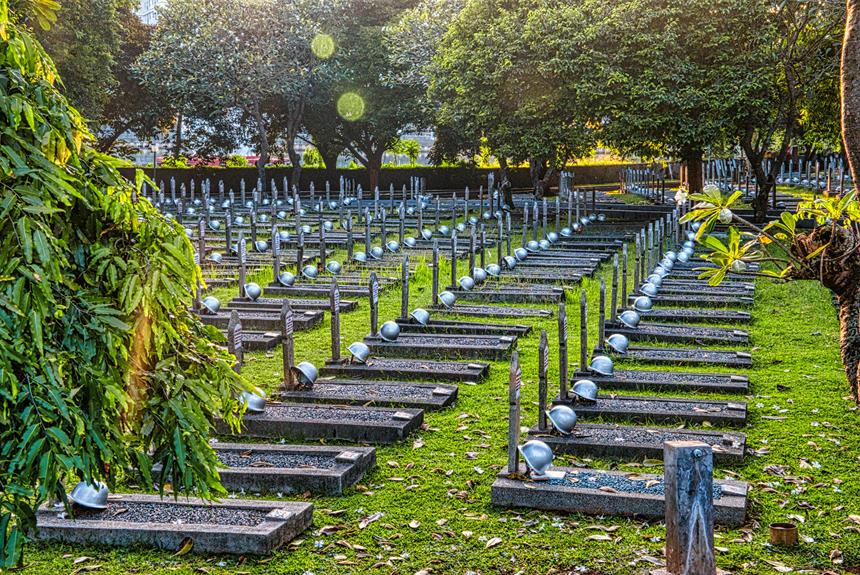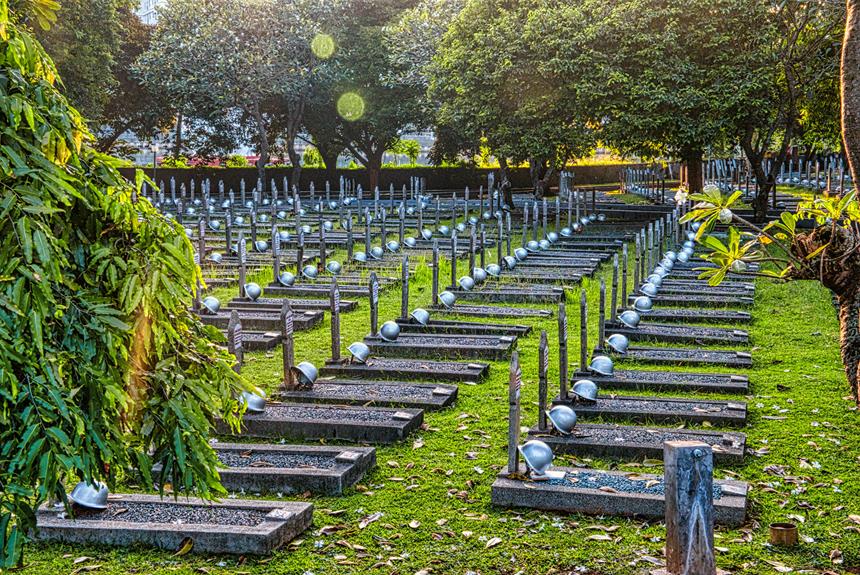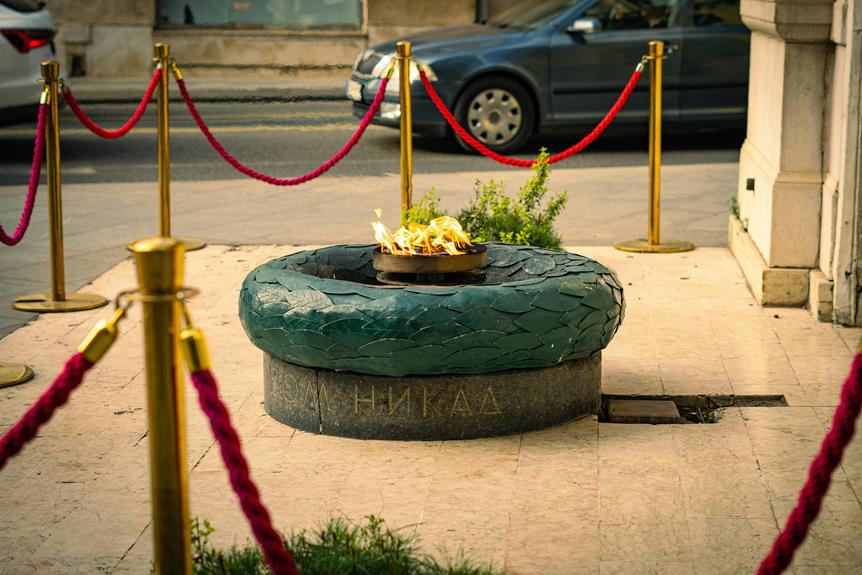The Armenian Genocide Memorial in Armenia stands as a solemn tribute to the indelible mark left by a tragic chapter in history. Its architectural elements and symbolic features intricately weave together a narrative of loss, resilience, and remembrance. Beyond its physical structure lies a profound story waiting to be explored, offering visitors a glimpse into the enduring legacy of a nation scarred by unspeakable atrocities. As one contemplates the significance of this memorial, one cannot help but ponder the broader implications and lasting impact it holds for generations to come.
Key Takeaways
- Symbolizes Armenian Genocide victims
- Features Eternal Flame and Walls of Names
- Offers educational experience on tragedy
- Promotes remembrance, unity, and justice
- Set in a serene natural environment
History of the Armenian Genocide
The Armenian Genocide, also known as the Armenian Holocaust, was a systematic campaign of extermination carried out by the Ottoman government against the Armenian population from 1915 to 1923. The causes of this tragic event can be traced back to tensions between the Armenian Christians and the ruling Muslim Ottoman Empire. The Armenians faced discrimination and were seen as a threat due to their different religious beliefs and aspirations for autonomy.
The consequences of the Armenian Genocide were devastating. Approximately 1.5 million Armenians lost their lives through mass killings, forced marches, and starvation. Families were torn apart, and communities were destroyed, leaving a lasting impact on the Armenian people. The survivors were left traumatized, displaced, and scattered across the globe, leading to a significant diaspora.
The denial of the Armenian Genocide by the Turkish government further exacerbates the consequences of this historical tragedy. The lack of acknowledgment prevents proper healing, reconciliation, and closure for the Armenian community. It also hinders international efforts to prevent future genocides by recognizing and learning from past atrocities.
Architecture of the Memorial
Symbolizing the enduring legacy of remembrance and resilience, the Armenian Genocide Memorial in Armenia stands as a poignant architectural symbol to the tragic events of the past. The architectural design of the memorial was meticulously planned to evoke emotions of reflection and commemoration. The construction process was a proof of the dedication of the architects and builders who aimed to create a space that honors the memory of the victims of the Armenian Genocide.
To provide a clearer picture of the memorial's architecture, the following table outlines key features of its design and construction:
| Feature | Description | Importance |
|---|---|---|
| Tsitsernakaberd | Central monument with 12 slabs representing provinces | Symbolizes unity of Armenian people |
| Eternal Flame | Symbol of remembrance for the lives lost | Represents memory that never fades |
| Walls of Names | Engraved with names of towns where massacres occurred | Honors victims and preserves history |
| Memorial Hall | Houses exhibitions and artifacts related to genocide | Educates visitors about the tragedy |
The architectural design of the Armenian Genocide Memorial, with its symbolic elements and thoughtful construction process, serves as a powerful reminder of the atrocities committed during the genocide. Each feature contributes to the overall solemn atmosphere and ensures that the memories of the victims are honored and preserved for future generations.
Symbolism and Significance
Portraying profound historical depth, what intrinsic meanings are embedded within the architectural elements of the Armenian Genocide Memorial in Armenia? The symbolism of the Armenian Genocide Memorial holds significant importance in remembrance commemorations. The twelve slabs of stone that form a circle represent the twelve lost provinces of Western Armenia. Each slab is positioned at a unique angle, symbolizing the irregular borders of these provinces. This intentional design serves as a poignant reminder of the land that was lost during the genocide.
The eternal flame at the center of the memorial symbolizes the undying memory of the victims and the hope for justice. It represents the resilience of the Armenian people in the face of tragedy and serves as a beacon of remembrance for future generations. The dark, somber colors of the memorial evoke a sense of mourning and solemnity, creating a space for reflection and contemplation.
The towering stele, reaching towards the sky, symbolizes the strength and perseverance of the Armenian people. Its height and imposing presence command attention, demanding that the atrocities of the past are never forgotten. The meticulous design and placement of each element within the memorial convey a deep sense of respect and honor for those who lost their lives during the Armenian Genocide.
Commemorative Events and Ceremonies
In the domain of remembrance and reflection, various commemorative events and ceremonies are held at the Armenian Genocide Memorial in Armenia. These events play an essential role in honoring the memory of the victims and providing a space for healing and solidarity among the Armenian community.
- Candlelight Vigils: Candlelight vigils are a common occurrence at the memorial, where individuals gather to light candles in memory of the lives lost during the genocide. This solemn ritual symbolizes hope and remembrance.
- Floral Offerings: Visitors often bring flowers to lay at the memorial as a sign of respect and remembrance. The act of laying flowers is a traditional way of honoring the deceased and paying tribute to their memory.
- Poetry Readings: Poetry readings are organized at the memorial, where poets recite works that reflect on the genocide and its impact. This cultural tradition allows for emotional expression and serves as a form of catharsis for both the speakers and the audience.
- Musical Performances: Musical performances are held to commemorate the victims of the genocide. Music has a unique way of conveying emotions and can be a powerful tool in the healing process for those affected by the tragic events.
- Moment of Silence: A moment of silence is observed during these events, allowing participants to reflect on the past and pay their respects to the victims. This moment serves as a collective act of remembrance and solidarity, fostering a sense of unity among attendees.
Visitor Experience and Reflection
The Armenian Genocide Memorial in Armenia offers visitors a profound opportunity for contemplation and introspection on the historical significance of the tragic events commemorated at the site. The experience at the memorial often evokes a deep emotional response and fosters a personal connection with the past. Visitors are encouraged to reflect on the atrocities committed during the Armenian Genocide and pay tribute to the millions of lives lost.
To enhance the visitor experience, the memorial provides various elements that aid in understanding and reflection. Below is a table detailing some of the key features that contribute to the overall impact on visitors:
| Feature | Description |
|---|---|
| Eternal Flame | Symbolizing remembrance and resilience, the eternal flame is a focal point for reflection. |
| Wall of Names | Lists the names of known victims, allowing visitors to honor individual lives lost. |
| Commemorative Artwork | Art installations convey the emotional toll of the genocide, prompting contemplation. |
| Reflective Garden | A serene space for quiet contemplation, offering visitors a moment of peaceful reflection. |
| Educational Exhibits | Informative displays provide historical context, deepening visitors' understanding of the genocide. |
These elements work together to create a somber yet impactful environment where visitors can engage with history on a personal level, fostering a profound emotional response and encouraging reflection on the enduring legacy of the Armenian Genocide.
Surrounding Landscape and Environment
Nestled within the scenic backdrop of Armenia, the Armenian Genocide Memorial is surrounded by a landscape that enhances the visitor experience and facilitates historical reflection. The natural beauty and ecological impact of the surroundings play a significant role in shaping the atmosphere of the memorial site.
- Breathtaking Mountain Views: The memorial site offers panoramic views of the majestic Armenian mountains, creating a sense of awe and reverence among visitors.
- Tranquil Garden Setting: The memorial is set amidst lush green gardens, providing a peaceful and contemplative environment for visitors to pay their respects and reflect on the tragic history of the Armenian Genocide.
- River Flowing Nearby: The gentle flow of a nearby river adds a soothing soundtrack to the memorial, contributing to the overall serene ambiance of the site.
- Flourishing Flora and Fauna: The diverse plant and animal life surrounding the memorial not only enriches the natural beauty of the area but also highlights the importance of preserving the ecological balance of the region.
- Sustainable Practices: Efforts to maintain the ecological balance around the memorial through sustainable practices demonstrate a commitment to preserving the environment for future generations, aligning with the memorial's message of remembrance and hope.
The harmonious integration of natural elements and sustainable practices at the Armenian Genocide Memorial creates a setting that invites visitors to connect with history, nature, and the enduring spirit of the Armenian people.
Memorial's Impact on Armenian Identity
Amidst the historical significance of the Armenian Genocide Memorial in Armenia, the profound impact on Armenian identity emerges as a compelling narrative. The memorial stands as a poignant reminder of the atrocities committed against the Armenian people during the genocide of 1915, shaping the collective memory and cultural identity of the Armenian nation.
The memorial's impact on Armenian identity is deeply rooted in its role as a symbol of resilience and remembrance. It serves as a physical manifestation of the Armenian people's strength in the face of adversity, honoring the memory of those who perished and reaffirming the Armenian commitment to preserving their cultural heritage.
Furthermore, the memorial's cultural significance extends beyond its role as a commemorative site. It serves as a focal point for the Armenian community, fostering a sense of unity and solidarity among Armenians both within the country and abroad. The memorial has become a place of pilgrimage for Armenians seeking to connect with their history and pay homage to their ancestors.
Preservation Efforts and Maintenance
Given the historical significance and cultural importance of the Armenian Genocide Memorial in Armenia, meticulous preservation efforts and regular maintenance are essential to ensuring its integrity and longevity. The memorial faces various conservation challenges due to its age and exposure to the elements, making ongoing care imperative for its continued existence. Securing funding sources for these preservation initiatives is crucial to sustain the memorial for future generations.
To address these conservation challenges and ensure the memorial's upkeep, the following strategies are being implemented:
- Regular Inspections: Conducting routine inspections to identify any signs of deterioration or damage is necessary for prompt maintenance and preservation efforts.
- Conservation Techniques: Employing specialized conservation techniques to address issues such as weathering, erosion, and structural integrity is critical for maintaining the memorial's original state.
- Community Engagement: Involving the local community in preservation efforts fosters a sense of ownership and pride, encouraging collective responsibility for the memorial's upkeep.
- Volunteer Opportunities: Providing volunteer opportunities for individuals passionate about heritage preservation allows for additional support in maintaining the memorial.
- Sustainable Funding: Establishing sustainable funding sources through partnerships, donations, or grants ensures ongoing financial support for preservation projects.
Through a combination of community engagement, sustainable funding, and strategic conservation efforts, the Armenian Genocide Memorial can be preserved for future generations to honor and remember the victims of the tragic events.
Educational Programs and Outreach
The preservation and maintenance of the Armenian Genocide Memorial in Armenia set a strong foundation for the development of educational programs and outreach initiatives aimed at fostering awareness and remembrance. Educational initiatives play a vital role in ensuring that the memory of the Armenian Genocide is preserved and passed down to future generations.
Community engagement forms an integral part of the educational programs associated with the memorial. By involving the local community, as well as national and international stakeholders, the memorial can reach a wider audience and have a greater impact. Educational initiatives such as guided tours, workshops, and seminars can provide visitors with a deeper understanding of the historical context and significance of the memorial.
Outreach efforts are essential for raising awareness about the Armenian Genocide and its implications. Through partnerships with educational institutions, museums, and cultural organizations, the memorial can expand its reach and engage with diverse audiences. Online platforms and social media can also be utilized to disseminate information and connect with individuals who may not be able to visit the memorial in person.
Future Plans and Developments
Moving forward, the strategic vision for the Armenian Genocide Memorial in Armenia encompasses a thorough framework for future plans and developments aimed at enhancing its impact and relevance. The following initiatives are key to achieving this vision:
- Expansion Plans: The memorial aims to expand its physical footprint to accommodate a larger number of visitors and provide space for additional exhibits and educational resources.
- Community Engagement: Establishing strong ties with the local community through outreach programs, educational workshops, and collaborative events to foster a sense of ownership and connection to the memorial.
- Public Art Installations: Integrating public art installations within the memorial grounds to create a multi-sensory experience that pays tribute to the victims of the Armenian Genocide and engages visitors on a deeper emotional level.
- Diversifying Funding Sources: To secure sustainability and growth, the memorial seeks to diversify its funding sources by collaborating with governmental bodies, international organizations, and private donors who share a commitment to preserving the memory of the Armenian Genocide.
- Technology Integration: Leveraging technology to enhance the visitor experience through interactive exhibits, virtual tours, and online educational resources that can reach a global audience and ensure the memorial's message endures for future generations.
Frequently Asked Questions
Can Visitors Participate in Any Interactive Exhibits at the Memorial?
Visitors can explore various interactive activities and participate in educational workshops at the memorial. These opportunities provide a hands-on learning experience, fostering deeper understanding and engagement with the subject matter.
Interactive exhibits offer a dynamic way for visitors to connect with the memorial's history and significance. Educational workshops provide a platform for visitors to investigate specific topics related to the memorial, enhancing their knowledge and creating a more immersive experience.
Are There Any Specific Guidelines for Respectful Behavior at the Memorial?
When visiting memorials, adherence to guidelines for respectful behavior is paramount. These guidelines serve as a compass, steering visitors towards honoring the solemnity of the site.
Understanding the psychological impact of one's actions is vital in maintaining the sanctity of such spaces. By respecting these guidelines, visitors can guarantee that their behavior contributes to the preservation and expansion of the memorial's significance.
Additionally, volunteer opportunities may arise for those seeking deeper engagement with the memorial's mission.
Are There Any Plans to Expand the Memorial in the Future?
Future expansion of the memorial is a topic of interest, with discussions often revolving around community involvement. Plans for expansion typically involve consultations with stakeholders, fundraising efforts, and architectural proposals.
Community engagement plays a crucial role in shaping the direction of any potential expansion, ensuring that the memorial remains a meaningful and inclusive space for all visitors. Collaboration between various groups and individuals is key to successfully executing plans for growth.
How Does the Memorial Address the Psychological Impact of the Genocide?
The psychological healing process facilitated by memorials often involves the acknowledgment of trauma, remembrance, and honoring the victims. Symbolism within memorials plays a vital role in addressing the psychological impact of tragedies like genocides.
Through the use of symbolic elements, such as architecture, artwork, and memorial rituals, these sites offer a space for reflection, mourning, and collective healing. Such symbolic gestures can provide solace and comfort to those affected by the atrocities.
Are There Any Opportunities for Visitors to Volunteer at the Memorial?
'Every cloud has a silver lining, and for visitors to this memorial, volunteer opportunities provide a chance to engage in meaningful work.
Interactive experiences await those who wish to contribute their time and efforts towards preserving the memory of past atrocities.
Conclusion
In summary, the Armenian Genocide Memorial in Armenia stands as a monumental confirmation of the enduring spirit and resilience of the Armenian people in the face of unimaginable tragedy.
With its powerful symbolism, educational initiatives, and cultural significance, the memorial serves as a beacon of remembrance and a symbol of strength for future generations.
Its impact on Armenian identity is profound and its preservation efforts guarantee that the memory of the victims will never be forgotten.


